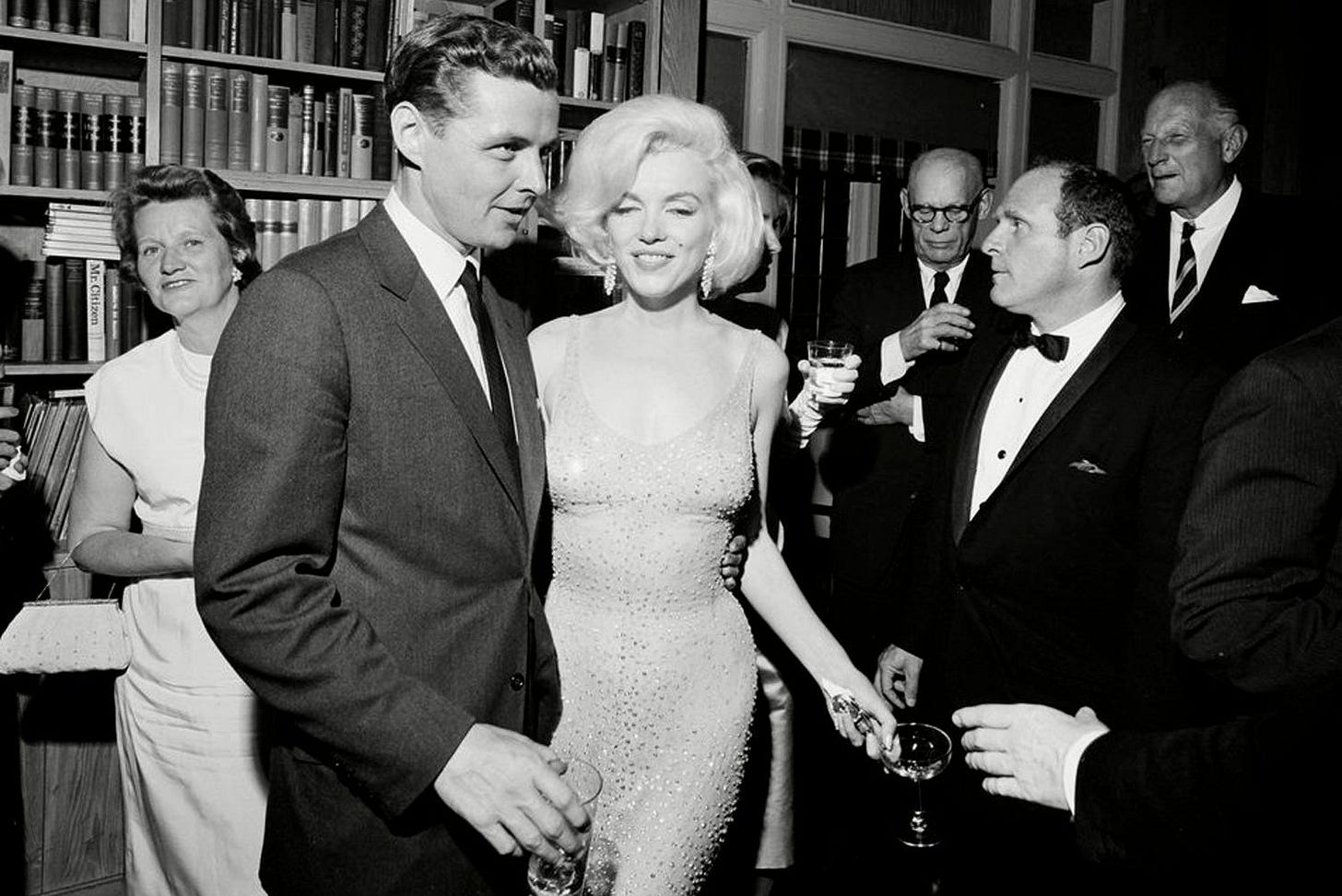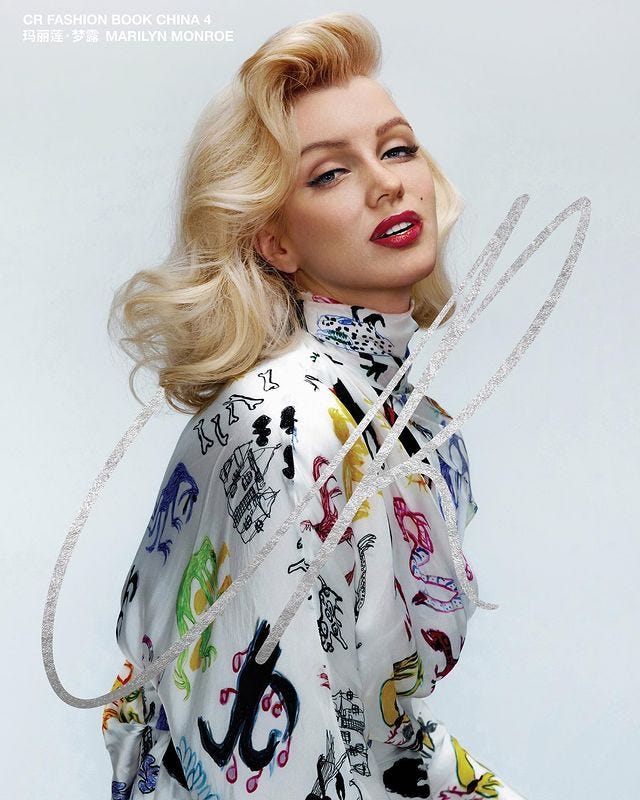Uncannily Monroe
Examining the continued use of Marilyn Monroe's image and concerns about bodily agency in a digital era.
Considering Marilyn Monroe died sixty years ago, her significant presence in popular culture to this day is remarkable. Throughout the first half of this year alone, Monroe has continued to make headlines and been the topic of debate amongst many. Notably, at this year’s MET Gala, Kim Kardashian caused outrage by arriving wearing a Jean Louis gown that was custom-designed for Monroe. Famously worn to serenade then-president John F. Kennedy on his 45th birthday in 1962, the garment was acquired in 2016 by Ripley’s Believe It or Not! and exhibited as ‘the most expensive dress in the world’ ($4.8 million). Previously described by Martin Nolan, executive director of Julien’s Auctions as ‘historical…political…a work of art [and representative of] a defining moment in history’, the franchise faced intense criticism for lending such an incredible historical artifact out. Dr. Justine De Young, professor of fashion history at the Fashion Institute of Technology claimed it was ‘irresponsible and unnecessary.’ Indeed, the dress is seen by many as a relic and representative of Monroe’s significance in American culture.

In May of this year, Christie’s auction house sold the iconic ‘Shot Sage Blue Marilyn’ portrait by Andy Warhol for $195 million, establishing it as the most expensive 20th-century artwork to sell at auction. A month later on the 6th of June, the trailer for Netflix’s Marilyn Monroe biopic ‘Blonde’ was released. Based on the novel by Joyce Carol Oates, Vogue reported that the plot ‘used her story to probe the often toxic nature of American celebrity’, rather than to provide a definitive account of Monroe’s life. Reflective of the way Monroe as a phenomenon is representative of popular American culture, her very essence is driven by connotations of glamour and laced with her ‘tragic’ narrative. This archetype blurred the boundaries of who Marilyn Monroe was as a cultural icon, and who Norma Jeane (her given name) was as a person.

The everlasting enchantment of Marilyn Monroe is evidenced through her continued prominence in contemporary media. Her voluptuous curves, breathy voice, and bright blonde hair have become the epitome of sexuality and glamour. Setting the tone for what is still considered classic Hollywood charm, Monroe imposed an ‘aesthetic code for the red carpet’ which still remains today. Emblematic of the era’s sexual revolution, Monroe was known for playing comedic ‘blonde bombshell’ characters, reinforcing the trope of *ditsy blonde*. Her public image was so overtly sexualised that her acting skills came second to her sexuality. Notably, in contemporary culture, it is stills from her films that have become more significantly recognisable than the movies themselves. The scene from the film ‘The Seven Year Itch’, for example, displays Monroe in a white halterneck dress with her skirt being blown up in New York City. Making cinematic history, the popular image became disseminated widely and immortalised as an iconic still.

The overtly sexualized image perpetuated of Monroe by the media was further capitalised on when she died at the age of 36. In her will, she left 75 percent of her estate to her acting coach Lee Strasberg, and when he later died, Monroe’s intellectual property rights were passed on to his widow Anna Mizrahi. Mizrahi signed licensing deals that allowed Monroe’s likeness to be used by various companies ranging from Mercedes-Benz to Coca-Cola. Monroe's image was used to endorse an array of products including vodka, cars, and cosmetics. It has been reported that Mizrahi made Monroe one of the highest-paid deceased celebrities in the world and in the four years between 1996 and 2000, she made more than $7.5 million in licensing revenue. Ultimately, the dissemination of Marilyn Monroe’s image through various endorsements, combined with the popularity of stills from her films has led to a long-standing cultural fascination with her. Certainly, Marilyn Monroe has become a definitive brand in our collective popular imagination with a significant detachment from the real woman who created her.
A few weeks ago, across eight different covers, a digitally re-imagined Marilyn Monroe starred in CR Fashion Book China’s fourth issue. Curated by CR’s Founder and Creative Director Carine Roitfeld, the images imagined Monroe ‘in what she might look like had her cultural heyday occurred today’, digitally dressed by brands including Balenciaga, Miu Miu, and Thom Browne. CEO Vladimir Roitfeld commented that ‘the CR Fashion Book brand has always looked towards fashion’s future,’ revealing that CR worked closely with web3 startup Amethyst with the eight covers to be sold as NFTs on Amethyst’s platform.
Predominantly, CR’s digital reimagining of Monroe has been criticized as ‘exploitative’ and ‘disrespectful’ on social media. Although many celebrities from Madonna, Lindsay Lohan, and Nicki Minaj have drawn influence from Monroe’s image, the use of CGI to create such an accurate likeness to that of a deceased person’s body has evoked collective discomfort. Gemma Williams remarked, ‘It is hard not to feel uncomfortable about the digital exhumation of a woman, one who can have no agency about how she is to be dressed, stood, photographed, looked at.’ Whilst it is true that Monroe has been preserved and ingrained in pop culture for decades, the conservation of her image is by no means as severe as its exhumation, where it will live ‘preternaturally preserved in the metaverse’.
Moreover, the unsettling appropriation of Monroe’s likeness raises pertinent issues around consent and ownership in a digital age. In looking at the eight *new* images of Monroe, the implied lack of agency over her extremely realistic portrayal is unsettlingly uncanny. A term used to describe the response to a realistically human object and the disturbing feeling it evokes, the 'Uncanny Valley' metaphor was first coined by the Japanese roboticist Masahiro Mori in 1970. This has continued to be observed in a variety of contexts over the years, ranging from video game characters to digital avatars that ‘aim for extreme realism but get caught in a disturbing chasm’. In light of Marilyn Monroe’s digital reincarnation, where technological advancements allow for a disturbingly accurate aesthetic reimagination, we must consider the ethical implications of these already exploited pop culture figures and how far we are willing to go when challenging their agency.




